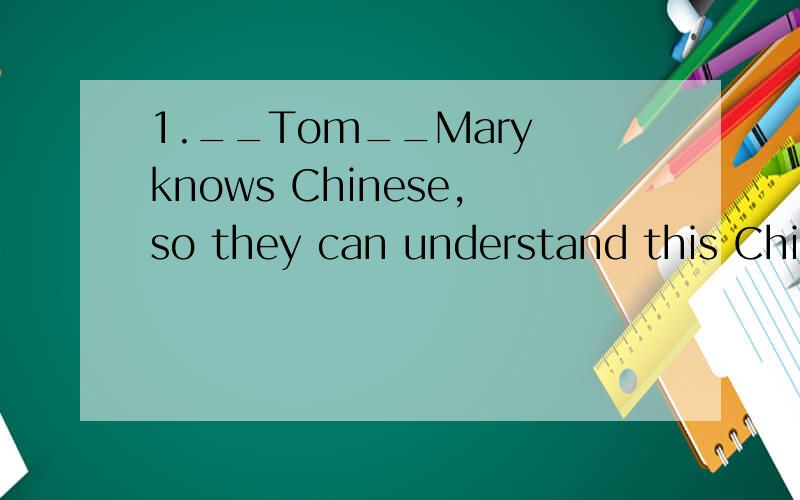1.__Tom__Mary knows Chinese,so they can understand this Chinese newspape....1.__Tom__Mary knows Chinese,so they can understand this Chinese newspape.A.Neither;norB.Not only;but alsoC.Both;andD.Either;or(请详细解释为什么选B而不选C,答案
来源:学生作业帮助网 编辑:作业帮 时间:2024/11/27 23:30:17

1.__Tom__Mary knows Chinese,so they can understand this Chinese newspape....1.__Tom__Mary knows Chinese,so they can understand this Chinese newspape.A.Neither;norB.Not only;but alsoC.Both;andD.Either;or(请详细解释为什么选B而不选C,答案
1.__Tom__Mary knows Chinese,so they can understand this Chinese newspape....
1.__Tom__Mary knows Chinese,so they can understand this Chinese newspape.
A.Neither;nor
B.Not only;but also
C.Both;and
D.Either;or
(请详细解释为什么选B而不选C,答案没能看懂- )
2.-Excuse me.Do you have a table for two?
-I'm sorry,__there aren't any seats now.Would you mind waiting for a while?
A.but B.and C.or D.so
(为什么选A?)
1.__Tom__Mary knows Chinese,so they can understand this Chinese newspape....1.__Tom__Mary knows Chinese,so they can understand this Chinese newspape.A.Neither;norB.Not only;but alsoC.Both;andD.Either;or(请详细解释为什么选B而不选C,答案
1.因为不是know而是knows,只有B符合就近原则
2.选A就是这么用的,你不能用你的理解来做题,要用外国人的思维来理解
第一道题不懂
第二道题不懂
第一道考主谓一致,第二道表示语气转换
both and 后面用单数谓语,not only but also后面用就近原则
1.因为不是know而是knows,只有B符合就近原则
2.选A就是这么用的,你不能用你的理解来做题,要用外国人的思维来理解
1. C的 话 know不要用三单 2. 翻译就好啦 A 很 抱歉,但是没有座位了 B 很抱歉,并且没有座位了 C 很抱歉 否则没有座位了 D 很抱歉 所以没有座位了 望采纳啊 5555 哭
B
原文意思是TOM 和MARY都懂中文,所以他们都能看懂中文报纸。
如果选A,那么表示都不懂
如果选C, 那么后面不能用单三
如果选D,那么表示只有一个人懂
第二题表示转折关系,其实你可以把I‘m sorry去掉,就很好理解了。
1. not only...but also 的谓语是就近原则,因此,动词用了单三knows. 而both...and的谓语总是用表示复数的动词,这里应该用know.
2. 这是一个语言习惯,在I'm sorry 之后的解释总是以but 开始。
第一题C答案不是就近原则,不能就knows,而应该用know
第二题but表示转折,根据句意不是转折啊,前面已经在道歉了啊
第一个就近原则,第二个,sorry后用but,习惯用法